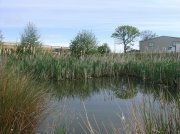Water Footprint
Every day we flush around 50 litres of water down the toilet - that's equivalent to a tank of petrol. And yet that water is as clean and healthy as the designer water that lines our supermarket shelves. We need to understand what we're doing with our water, and learn to respect its value.
At Steenbergs, we are acutely aware of the vulnerability to the world's ecosystems to water for example:
- Water shortages, e.g. in Murcia, Spain, from vast tourist urbanisations that come complete with verdant golf course;
- Increased flooding, e.g. in low-lying Bangladesh as annual monsoons run off in the Bay of Bengal will increase flooded area by 40% and a 2oC rise in temperature would see the flow in the Meghna and Brahmaputra rivers increase by 20%;
- Water pollution, e.g. freshwater pollution in the UK from chemical pollution from fertilisers and disused coal mines, organic pollution from sewage and heat pollution from power stations. In 2018-19, there were 493 notifiable serious pollution incidents, with half coming from the water industry and agriculture.
Steenbergs' Targets
| Targets (2016 - 2025) | 2025 | Actual |
| Reduction in water usage | -25% | -7% |
Where Does Our Water Comes And How Is Wastewater Treated?
At Steenbergs, the water is potable water abstracted from one of the UK's most important aquifers, the Triassic sandstone aquifer of the Vale of York. The water is untreated freshwater that has been slowly filtered through the permeable sands and gravels. As a private water supply, its potability is monitored and regularly tested under the Private Water Supplies (England) Regulations 2016 by Harrogate Borough Council, plus we randomly do our own testing.
Waste water is, also, treated on site, managed by the site owners Barker Business Park. Sewerage and waste water is firstly treated through a microbial (mainly bacterial) treatment plant, then the water is "polished" through a reed bed filtration system (see photo above) before being released into the watershed - not directly into any watercourses but into the local farmland, which is owned by the estate owners.

 Print this page
Print this page Bookmark this page
Bookmark this page